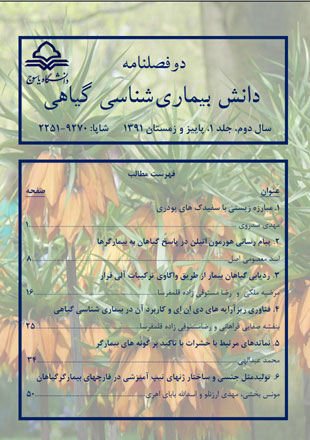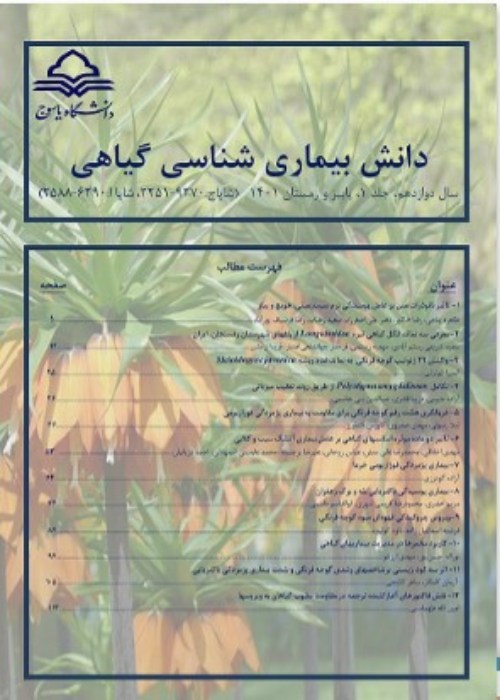فهرست مطالب

نشریه دانش بیماری شناسی گیاهی
سال دوم شماره 1 (پیاپی 3، پاییز و زمستان 1391)
- تاریخ انتشار: 1391/10/11
- تعداد عناوین: 6
-
-
صفحه 1سفیدک های پودری از قارچ های انگل های اجباری مهم گیاهان هستند، که با به وجود آمدن پوشش سفیدرنگ روی قسمت های هوایی آن-ها باعث زردی، خشکی و کاهش کمی و کیفی محصول گیاهان زراعی، درختان میوه، جالیز و زینتی می شوند. از بین روش های مبارزه با این بیمارگرها تنها امکان استفاده از قارچ کش ها بعد از بروز آن-ها وجود دارد، ولی به دلیل خطرات زیست محیطی استفاده از سموم شیمیایی، امکان باقیماندن آن ها در محصول و گزارش مقاومت به قارچ کش ها در بعضی از سفیدک های پودری، مبارزه زیستی با این بیمارگرها مورد توجه قرار گرفته است. قارچ های Ampelomyces quisqualis، Pseudozyma flocculosa و Lecanicillium longisporum، باکتری Bacillus subtilis، کنه Tydeus lambi و کفشدوزک 20 نقطه ای Psyllobora vigintimaculata به طرز موثری در مبارزه با سفیدک های پودری خیار، کدو، گوجه فرنگی، فلفل، انگور و رز استفاده شده اند و تعدادی از آن ها به شکل تجارتی به بازار نیز عرضه شده اند.
کلیدواژگان: باکتری، سفیدک پودری، سوسک، کنه، قارچ -
صفحه 8گیاهان با دامنه ای از سازوکارهای مولکولی - بیوشیمیایی ذاتی یا القایی، استراتژی هایی را برای سازگاری به تغییرات محیطی ایجاد کرده اند. پاسخ مناسب گیاه، از طریق دریافت پیام خارج سلولی و انتقال آن به درون سلول های گیاهی ظهور می یابد. اتیلن به عنوان هورمونی شناسایی شده است که واکنش های گیاهی را تحت شرایط محدودکننده رشدی کنترل می کند. تولید اتیلن در واکنش به تنش های زیستی مثل آلوده شدن گیاه با بیمارگرها یا حمله گیاه خواران افزایش می یابد. اکثر ژن-های مقاومت توسط مسیر پیام رسانی اتیلن القا می شوند. مسیر بیوسنتز اتیلن از اسید آمینه متیونین به خوبی شناخته شده است و اتیلن تولیدی باعث فعال شدن ژن های مقاومت و بروز واکنش های دفاعی گیاهان می شود. ژن های موثر در پیام رسانی اتیلن در برنج و نیز ژن های مقاومت که با تیمار اتیلن افزایش بیان نشان می دهند، معرفی شده-اند.
کلیدواژگان: پیام رسانی، بیمارگر، اتیلن، دفاع، گیاه -
صفحه 16امروزه با توجه به نیاز به بهبود کمیت و کیفیت محصولات کشاورزی، مسئله حفاظت از گیاهان بیش از پیش مورد توجه قرار گرفته است. یکی از راه های رسیدن به مدیریت موفقیت آمیز بیماری-های گیاهی یافتن راهی برای شناسایی و ردیابی دقیق بیمارگر های گیاهی است. از روش هایی که در تشخیص بیماگر های گیاهی به کار می-رود، واکاوی ترکیبات آلی فرار منتشر شده از گیاهان بیمار است. در این روش باید به اختصاصی بودن ترکیبات آلی فرار منتشر شده، عوامل موثر بر شناسایی بیماری از طریق این ترکیبات و روش های موثر بر تعادل این ترکیبات توجه نمود. به این منظور ابتدا این ترکیبات باید جمع آوری شده، سپس واکاوی شوند. مناسب ترین روش برای واکاوی این ترکیبات در محصولات کشاورزی نمونه برداری پویا به همراه انجام کروماتوگرافی گازی و استفاده از ردیاب مناسب است. اگرچه به دلیل هزینه زیاد تجهیزات، استفاده از این روش در کشاورزی دشوار است، اما با استفاده از روش ها و برآورد های آماری می توان این هزینه را کاهش داد.
کلیدواژگان: آلی، بیمار، فرار، کروماتوگرافی، گیاه -
صفحه 25فنآوری ریزآرایه های دی ان ای، روشی برای اندازه گیری بیان ژن-ها در مقیاس بزرگ است که بر پایه بررسی دورگ سازی بین توالی های کاوشگر و هدف استوار شده است. همچنین از این فنآوری می توان برای شناسایی موجودات مختلف نیز استفاده کرد. در ریزآرایه های دی ان ای مجموعه ای از کاوشگرها به صورت نقاط ریز میکروسکوپی به یک سطح جامد متصل می شوند، پس از انجام دورگ سازی بین توالی های کاوشگر و هدف، میزان دورگ سازی با استفاده از روش های مختلفی مانند اندازه گیری میزان تابش رنگ های فلورسان مشخص می شود. بخش-های مختلف یک آزمایش مبتنی بر فنآوری ریزآرایه های دی ان ای شامل ساخت تراشه دی ان ای، آماده کردن توالی هدف، انجام دورگ سازی، جمع آوری و واکاوی داده ها است. فنآوری ریزآرایه های دی ان ای درزمینه های مختلف بیماری شناسی گیاهی، از جمله تشخیص گونه های قارچ ها، باکتری ها، نماتدها و ویروس ها و بررسی برهم کنش گیاه- بیمارگر کاربرد دارد.
کلیدواژگان: ریزآرایه، دورگ، دی ان ای، ژن، فنآوری -
صفحه 34اغلب نماتدها آزادزی هستند. آن ها در دریاها، آب های شیرین و خاک زندگی و از باکتری ها، قارچ ها و سایر نماتدها تغذیه می کنند. بعضی شکارچی و عده ای انگل گیاهان و جانوران هستند. از بین نماتدهای انگل جانوری، برخی با حشرات در ارتباط هستند. نوع ارتباط نماتد با حشره در گروه های مختلف متفاوت است. نماتدهای مفیدی که موجب ایجاد بیماری در حشره می شوند، اصطلاحا بیمارگر حشرات نام دارند که توانایی کشتن حشرات را دارند. ثابت شده نماتدهای بیمارگر از جنس های Stein ernema و Heterorhabditis موثرترین عوامل مهارزیستی حشرات هستند. لاروهای این نماتدها قادرند در خاک زندگی کرده، حشره میزبان را بیابند و به درون بدن آن نفوذ کنند. در این مقاله انواع رابطه موجود بین نماتدها و حشرات، با تاکید بر نماتدهای بیمارگر حشرات بیان شده است.
کلیدواژگان: بیمارگر، حشره، نماتد، Stein ernema، Heterorhabditis -
صفحه 50در سلسله قارچ ها، تولید مثل جنسی با ژن گاه خاصی تحت عنوان ژن گاه تیپ آمیزشی تنظیم می شود. این ژن گاه از نظر ساختاری غیرمعمول است، زیرا 2 فرم متناوب (آلل) با توالی کاملا غیر مشابه را شامل می شود که فاکتورهای نسخه برداری متفاوت را رمزگذاری می کنند، اما در عین حال یک موقعیت کروموزومی را اشغال می کنند. این مشخصه ژنومی مهم به صورت گسترده در بزرگترین شاخه قارچ ها، Ascomycota که بسیاری از قارچ های بیمارگر گیاهی را شامل می شود، مطالعه شده است. در مقاله حاضر سعی براین است تا جنبه های مختلف ژن های تیپ آمیزشی مورد بررسی قرار گرفته و ساختار این ژن ها در این شاخه بحث شود. آشنایی با این مقوله می تواند کمک شایانی به افزایش دانش ما از پتانسیل تشکیل چرخه تولید مثل جنسی در قارچ های بیمارگر گیاهی و بدنبال آن تنوع ژنتیکی در جمعیت های قارچی داشته باشد. کسب دانش لازم در زمینه تولید مثل جنسی و تنوع ژنتیکی قارچ های بیمارگر گیاهی از جنبه های مختلف در مدیریت بیماری های گیاهی مفید است.
کلیدواژگان: ایدیومورف، تیپ آمیزشی، تولید مثل جنسی، ژن، Ascomycota
-
Page 1Powdery mildew fungi are important obligate parasites of plants. They produce white cover on aerial parts of host plants, which then turn to yellow. The diseased plant becomes yellow and then wilted result in reducing quality as well as quantity of products in field and vegetable crops and also fruit trees. Among all of the control measures against powdery mildew, the most common method is application of the chemical fungicides, after disease incidence. Regarding to the hazards of agrochemicals and also considering the probability of incidence of resistant races of the pathogen, the biological control is considered as a safe and useful method for controlling the disease. The fungi Ampelomyces quisqualis, Pseudozyma flocculosa and Lecanicillium longisporum; the bacterium Bacillus subtilis; the mite Tydeus lambi and twenty-spotted lady beetle Psyllobora vigintimaculata, have been used effectively against the powdery mildew of cucumber, squash, tomato, pepper, grape and rose. Some of these biological agents have been introduced to the market, commercially.Keywords: Bacterium, Powdery mildew, Beetle, Mite, Fungus
-
Page 8There are some strategies for adaptation to environmental changes in plants, including a range of molecular-biochemical and also intent or induced mechanisms. The proper response of plant is occurred when it receives extracellular signals and transfers those inside the cell. Ethylene, identified as a plant hormone which regulates the plant reactions under some circumstances. Ethylene production has been enhanced in response to biological stresses like plant infection by pathogens or herbivores attack. Most of induced defense genes are regulated by transduction pathways signal. The biosynthesis pathway of ethylene from the amino acid methionine has been studied well. In this pathway, the produced ethylene activates the resistant genes resulting to incidence of plant resistance. The responsible genes in rice and also the ethylene-expressed resistance genes have been discussed in this review.Keywords: Signaling, Pathogen, Ethylene, Defense, Plant
-
Page 16Regarding to the need of improving the quality and quantity of agricultural products, the science of plant protection has been taken under consideration. Accurate identification and detection of plant pathogens is one of the best ways for successful plant disease management. One of the useful methods is analysis of the volatile organic compounds, which spread from diseased plants. In this method, specificity of the volatile organic compounds and also the factors that affect the identifying of plant diseases and effective methods on these compounds are important. First, these compounds should be collected and then be analyzed. The best method for analysis of these compounds is dynamic sampling followed by gas chromatography and using the proper probes. Although the high costs of the tools make it difficult to apply this method for agricultural purposes, but by using the statistical methods and estimations the costs can be decrease.Keywords: Organic, Disease, Volatile, Chromatography, Plant
-
Page 25DNA microarrays technology is a method for studying the gene expression in large scale, based on investigations of probes and targets hybridization. This technology can also be used for identification of different organisms. DNA microarrays are a set of probes linked to a solid phase as microscopic spots. After hybridization of targets to probes, hybridization level is calculated by means of different methods such as measuring refulgence of fluorescent dyes to determine gene expression level. A microarray examination has different steps: making DNA chips, preparing targets, performing hybridization, and gathering and analyzing data. DNA microarrays technology can be used in different fields of plant pathology such as identification of different species of fungi, bacteria, nematodes and viruses, and to study plant-pathogen interaction.Keywords: Microarray, Hybrid, DNA, Gene, Technology
-
Page 34Most nematodes are free-living. They live in oceans, fresh waters and soil and feed on bacteria, fungi and other nematodes. Some are predators and some are parasites of plants and animals. Some of the latter group are insect-associated. There are different types of relations between insects and nematodes. Beneficial nematodes that cause disease in insects are referred to as “entomopathogenic” and have the ability to kill the insects. Entomopathogenic nematodes from the genera Stein¬ernema and Heterorhabditis have proven to be the most effective as biological control organisms. Only the infective juvenile stage of entomopathogenic nematodes will survive in the soil, find and penetrate insect pests. In this paper, different types of association between nematode and insect with emphazing on entomopathogenic nematode species have been reviewed.Keywords: Pathogenic, Insect, Nematode, Steinernema, Heterorhabditis
-
Page 50Sexual reproduction of fungi is governed by the mating type (MAT) locus. Because two alternate forms (alleles) are completely dissimilar sequences and encoding different transcription factors, this locus is structurally unusual, yet they occupy the same chromosomal position. Genomic analyses facilitate the definition of MAT locus sequences in many species, so the knowledge of MAT locus structure and evolution has been significantly advanced in recent years. This important genomic feature has been studied most extensively in the largest phylum of the fungi, Ascomycota, which is the largest group of the plant pathogenic fungi. In this article we discuss the different aspects of mating type genes and their structure and organization in Ascomycota. Knowledge on the mating type genes may provide a great assistance to understanding the potential of phytopathogenic fungi for sexual cycle and consequently on genetic diversity in fungal populations. The proper data on sexual reproduction and genetic diversity of phytopathogenic fungi might be useful in different aspects of plant disease management.Keywords: Idiomorph, Mating type, Sexual reproduction, Gene, Ascomycota


